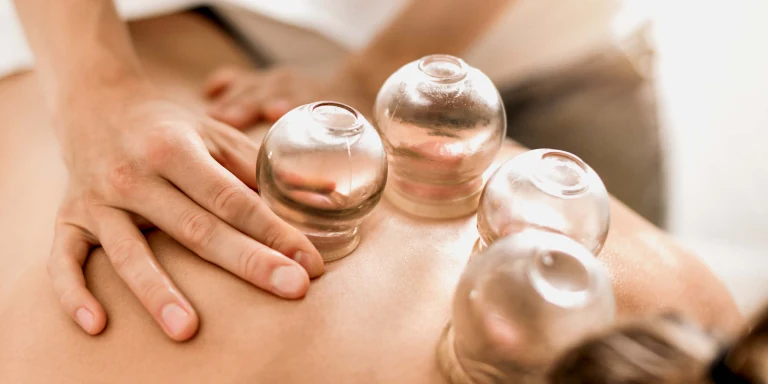Cupping: definition, effects & costs
What effect does cupping have? How much does this treatment cost? Does cupping have any side effects? Find out all about dry cupping, wet cupping and cupping massage here.

What is cupping?
Cupping is one of the oldest forms of treatment and is used in traditional Chinese medicine or TCM, among other things. Cupping therapy is offered by TCM therapists and alternative practitioners, but also in doctors’ offices that specialise in naturopathy. Additionally, cupping is used in physiotherapy, occupational therapy and massage therapy. There are various methods: dry cupping, wet cupping and cupping massage.
What does cupping do?
Cupping seeks to boost general well-being and activate the body’s self-healing powers. It involves therapists placing special cupping glasses on the skin and generating a suction effect by creating a vacuum, improving the blood flow through the skin, connective tissue and muscles underneath them. The enhanced lymph flow is said to help the body break down toxins and waste products.
What can cupping help with?
Cupping is a versatile treatment and one that can be used for a range of different ailments. Therapists usually concentrate on areas of the body like the back, arms and legs. What issues is cupping effective for? Potential areas of application:
- Muscular tension
- Cupping for back pain, tension and muscle stiffness
- Headaches
- Nerve pain
- Osteoarthritis and arthritis
- High blood pressure
- Weak immune system, fatigue
- Digestive issues
- Menopause or menstruation symptoms
- Depressive moods
- Asthma
- Cupping to help with weight loss
- Scar treatment
- Improving skin, e.g. facial cupping or cupping to treat cellulite
Cupping – who covers the costs?
Helsana endorses cupping as part of a complementary medicine approach and contributes to the treatment costs in line with your supplementary insurance policy. If you have SANA or COMPLETA, you will receive 75% of the invoice amount. COMPLETA PLUS covers 15% of the invoice amount up to CHF 500 per calendar year, on top of that covered under COMPLETA. The therapist must be recognised by Helsana for cupping. You can use our Search complementary therapists feature to check this.
How does cupping work?
Before starting the cupping treatment, the complementary therapist will examine you for any skin changes such as asymmetries or inflammation. They will then palpate your body to assess blood flow and muscle condition. Your therapist will choose the type of cupping and the cupping sites depending on the result and your personal concerns.
Dry cupping
With this form of cupping, the effect is generated by the therapist placing cupping glasses on your intact skin, before creating a vacuum in the glasses. The cupping glasses remain on the skin for around 15 minutes. This method can be used for conditions such as circulatory disorders or osteoarthritis, for example.
Wet cupping
With wet cupping, the effect is generated by small, superficial incisions in the skin. Before the specialist places the cupping glasses on your skin, they will disinfect the skin and make light scratches on it. Subsequent bleeding is a totally normal and desired effect of wet cupping. This method is intended as a means of expelling harmful substances from the body. It is beneficial because it improves blood and lymph flow and can influence organs via specific cupping sites on the body.
Cupping massage
Cupping massage combines the effect of dry cupping and massage. Here, the cupping glasses are dragged over oiled areas of skin, promoting blood flow. A massage using cupping glasses can relieve tension and loosen the muscles.
Cupping: how long and how often?
How often you should undergo cupping therapy depends on the ailment. As a rule, you should not have cupping performed on more than two areas of the body per day. Take a gradual approach. Start with a few minutes before progressing to leaving the cupping glasses on the skin for around 5–15 minutes. If they fall off on their own or bruises form, stop cupping.
Cupping at home: dangerous?
Many people follow guides on how to perform cupping therapy on themselves, whether to get rid of tension or for cosmetic reasons. However, only dry cupping or cupping massage are suitable for self-treatment – wet cupping should be done by a trained specialist. Bear in mind the following points when attempting cupping yourself, and ask a professional beforehand if you’re unsure about anything:
- Cupping glasses: only opt for high-quality cupping glasses that are designed specifically for home use.
- Pick the right location for the cups: exclusively perform cupping on easily accessible muscles, don’t place the cups over bones, and only use them on intact skin.
- Position them correctly: place the cupping glasses on the affected areas, e.g. anywhere you notice pain or tension. Massage cream or oil into the relevant part of the body beforehand if need be.
- Duration: do not leave the cupping glasses on one area for too long. Start with short applications of just a few minutes.
Important: there are some circumstances, listed below, under which you should categorically avoid cupping. Always consult your GP practice first if you suffer from any health problems.
Cupping: are there any side effects or risks?
Cupping is regarded as a form of therapy with minimal side effects. But, as with all treatment methods, there are a few risks that you should be aware of. One of the most common side effects is bruising following cupping. These blood effusions are a natural response to the stimulus applied and will disappear in a few days or weeks. Occasionally, patients may experience pain – especially if the negative pressure is set too high.
There is also a risk of infection with wet cupping. However, this risk is minimal if treatment is performed by an experienced professional.
One other potential side effect of cupping is an initial deterioration, whereby the symptoms temporarily worsen at the start of the therapy. It is important that you ask if you are unsure or experience unexplained symptoms.
When should you avoid cupping?
Before you opt for a treatment, you should bear a few contraindications in mind. Caution is advised in the following cases:
- When taking blood thinners or if you are at risk of haemorrhage
- Injury or inflammations of the skin (e.g. eczema, acne, sunburn, sensitive skin)
- Cupping in pregnancy
- Cardiac arrhythmia, heart failure, pacemaker
- Cancer, following radiotherapy
Seek medical advice under such circumstances to rule out any risks. Your doctor is the best person to appraise your symptoms and your medical history and can derive recommendations for treatment on the basis of this.
Got any questions about cupping?

Articles about this topic
Liability exclusion
The health information provided here is of a general nature and is intended exclusively for information purposes. It is not a substitute for medical advice. In the event of a health problem, you should always consult a doctor or medical specialist.
Do you have questions?
We're here to help.

